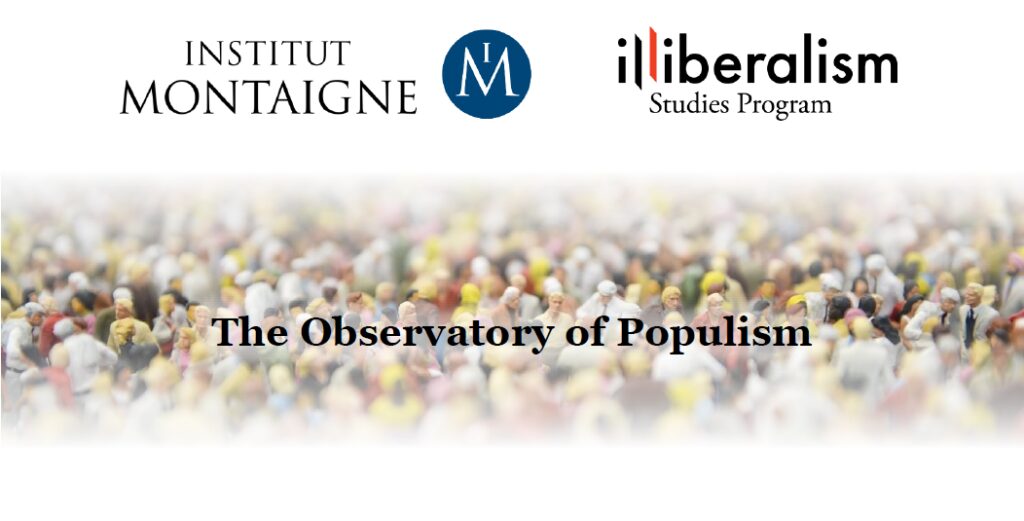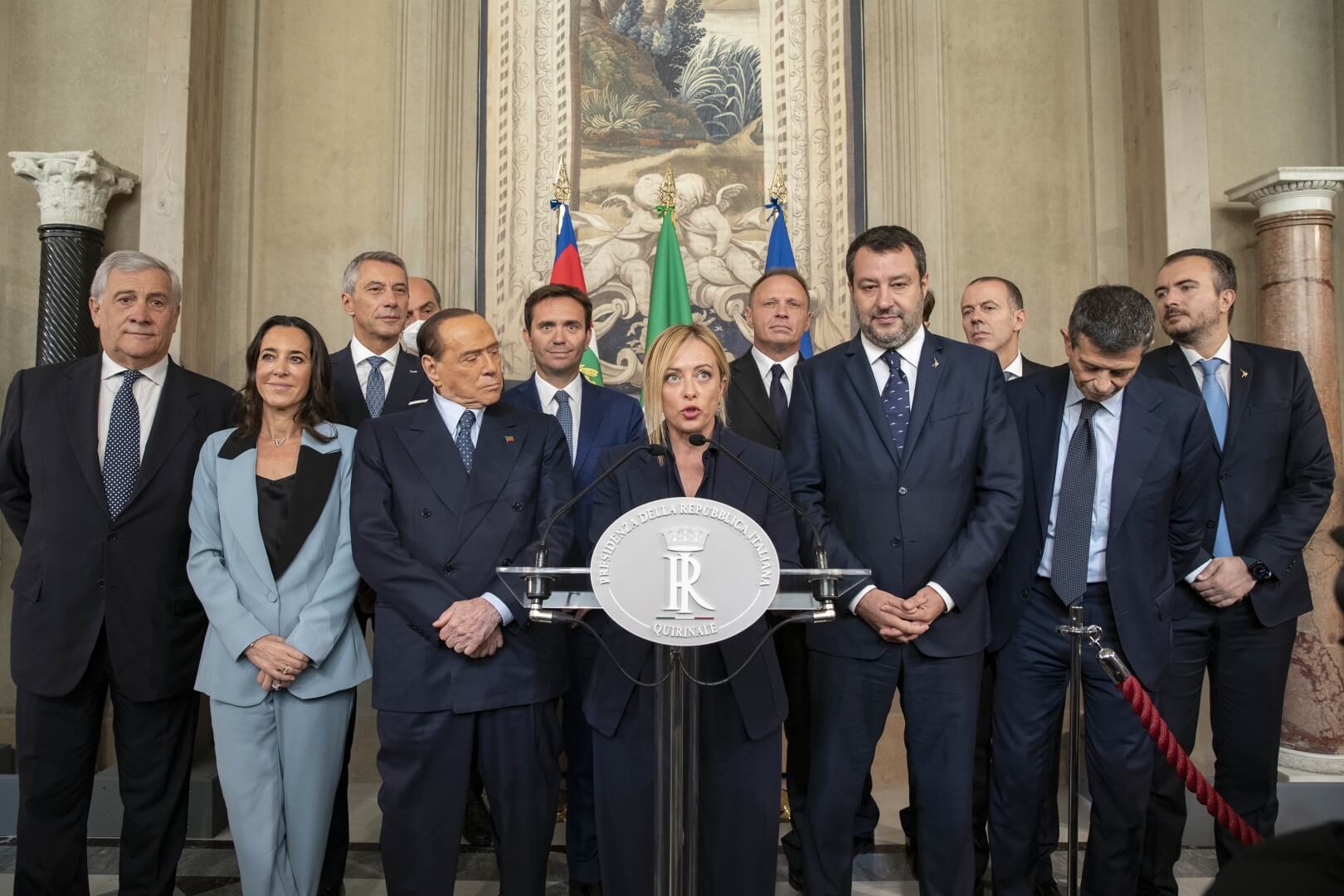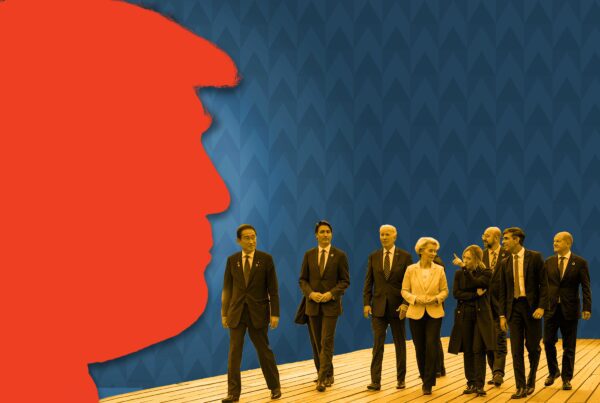
This article, belonging to the Observatory of Populism, is part of Institut Montaigne’s new partnership with the Illiberalism Studies Program at George Washington University, which will extensively cover populist voices, whether in Brazil, Europe, or in the crowded US midterm election landscape. For our second discussion session, we interviewed Marc Lazar, Emeritus Professor at the History Center Sciences Po Paris, and Eric Chaney Economist Advisor to Institut Montaigne. Both Marc and Eric provide their analysis of the incoming Italian government.
On October 25, Giorgia Meloni gave her maiden speech addressing the Italian parliament after being sworn in the previous Saturday as Italy’s new prime minister. In her speech, she outlined the priorities of her new government and gave some indications as to how her government would approach several key issues.
The Political Dimensions
Composition of the New Government
The new Italian government is a uniquely personalistic one, centered around Georgia Meloni the person, and Brothers of Italy (Fratelli d’Italia; FdI) the party. There is an irony underpinning this fact, which is that Meloni is a post-fascist leading a country with an anti-fascist constitution, though she has attempted to distance herself from anti-democratic and fascist sentiments. This personalism is the result of several factors: Fratelli’s capture of 26% of the vote, the largest share by far; Meloni’s high approval rating of 53%; Fratelli’s crowding out of other right-wing parties like Silvio Berlusconi’s Forward Italy (Forza Italia; FI) and Matteo Salvini’s League (Lega; LSP); the realignment of the Italian rightwing away from a center-right coalition with a predominant center to a right-center coalition with a predominant radical right; and the Italian electorate’s deep desire for an individual who can bring political stability to an unstable political system. In other words, Meloni is quite well positioned, despite tensions within her own coalition.
The composition of the new government reflects these dynamics. It will be comprised of 9 ministers from Meloni’s FdI, 5 ministers from Lega, and 5 ministers from Forza, with the remaining ministries staffed with “technicians,” i.e. technocrats. Several of the ministries will undergo cosmetic changes, with the Ministry of Firms becoming the Ministry of Firms and Made in Italy, and the Ministry of the Family becoming the Ministry of Family & Natality & Equal Opportunity. The latter will be led by a fervently anti-abortion activist.
These moves reflect the “double face” of the new government. On the one hand, Meloni wants to project responsibility, to the European Union, the United States, and to the markets. Her appointment of technocrats to key ministries seems to have done just that, as the markets have remained stable. The other face is more ideological, projecting radical right and national conservative values evident in the Ministries’ name changes alone, as well as their appointed leaders. The attempt of protectionism and natalism suggested by the name changes are a way for Meloni to re-emphasize ‘the nation,’ a common theme for those on the radical right. Giorgia Meloni and her party are a mix of post-fascism, radical right, conservatism and nationalism. Her slogan, God, Family, Homeland is a good synthesis of her ideology which offers to make Italy great again to the Italian people.
What Will a Meloni Government Do?
The first priority of Meloni’s government, as is the case around the world, will be to steer the economic ship back to shore and tamp down on inflation. Fratelli’s plan for doing so is a mix of economic liberalism, via tax cuts and deregulation, and social protection for groups like artisans and pensioners. But it will be a difficult task, and the new government’s inability to solve the inflation problem will likely lead to a pivot to other issues that are more realistically controllable. At the top of this list are migration and security. Meloni has pledged to prevent the arrival of migrants but admits that a “European solution” is needed and that a single national government cannot curb the issue itself. Natality will be another priority of this government, which may try and promote family formation through cash transfers to families and spending on pro-life campaigns. A re-stressing of protectionism is also bound to emerge, as evidenced by Meloni’s “Made in Italy” posturing. Italy’s regulatory environment already provides a de facto protectionist cover to Italian businesses, shielding them from various forms of competition. But more can be done, probably not in the goods market but in the services market. Relations with the European Union will take priority, and Meloni has gone out of her way to stress that she is pro-EU, relieving worries that many had about her given her association with traditionally eurosceptic right-wing movements. But it is still an open question as to where and how Italy will position itself within the EU. There is some concern that Meloni will be pro-EU, but only in the narrowest sense, pushing for a European Union that is closer to a voluntary confederation than a deeply integrated union. In practice, Italy could align itself with rogue actors in the EU like Poland and Hungary, though Italy and Hungary will fall on different sides of the Russia-Ukraine debate. Finally, there will be a domestic push by Meloni to change the Italian constitution to allow for the direct election of an Italian president, with increased powers. Meloni’s coalition currently falls short of the ⅔ majority needed to make such a change, but it will advocate for it nonetheless and organize a referendum.
Relationship with Neighbors: The Case of France
Georgia Meloni, and the Italian radical right in general, have been highly critical of France and of President Emmanuel Macron specifically. It shouldn’t come as a surprise that Meloni would depart from Macron, but it’s interesting to note that Meloni and Fratelli depart even from their counterparts on the French radical right. The divergences are largely the product of structural and material differences. The structural reality of the Italian political system, in which collaboration is a necessity, makes FdI more willing to engage with mainstream political actors than say, Marine Le Pen’s National Rally (Rassemblement National; RN). Meloni is also more conservative (i.e. Christian and traditionalist) than Le Pen. Eric Zemmour’s political project in France is closer to Meloni’s vision, both in his desire to “unite the right,” something that Italy’s new government is essentially a poster of, and in his traditionalist, conservative values. But in rhetorical strategy, these two diverge as well, mostly on questions of how to use history. Meloni avoids speaking of history, in part because her personal (and her party’s) history is fascist and unpopular. Zemmour on the other hand leans into revisionist history in an attempt to reformulate French history and build a national identity. Meloni is in some ways the poster child for a new brand of populism, one which is intends not just to criticize but to govern. The populist radical right in France has yet to reach this stage.
The Economic Dimensions
State of the Economy
Despite its reputation, the state of the Italian economy is a mixed bag. To be sure, it suffers from long-term structural difficulties. Moreover, the state of Italy’s economy has worsened in important ways since joining the Eurozone, something that was not supposed to happen. Italy’s public debt-to-GDP ratio was declining prior to joining the Euro and reached around 110% of GDP before increasing to its current levels (153% of GDP) under the Eurozone regime. However, Italy’s debt-to-GDP ratio when measuring public and private debt is around 276% of GDP, which is the middle of the pack for advanced, Western democracies. What this indicates is that public borrowing crowds out household and corporate borrowing, leading to less productive lending but also Italian companies that are solvent and in a good position overall. The paradox is that in order for the Italian government to reign in its debt, it has cut spending in sectors that produce growth in the long-term like infrastructure and education, while continuing to spend on servicing its current debt and on cash transfers, therefore prolonging the structural difficulties. The Italian debt paradox will continue to sting, especially as the world economy moves into a high-interest-rate environment.
Fratelli’s Economic Program
The most important to-do for the new government is to pass the budget, a task started under the departing Draghi government. The fact that the budget process is well underway has helped calm the markets as the political transition has moved along. Because of Italy’s structural constraints, the budget is unlikely to change much from the version outlined by the Draghi government. Nonetheless, the new government faces two daunting agenda items:
Reducing Inflation: There will be a call to shelter Italian consumers’ purchasing power through government intervention but due to the constraints and debt situation outlined above, the Italian government will have far less maneuverability than its counterparts in Germany or northern Europe. Still, the new government will likely spend money to protect consumers, and the Italian public and the markets will not complain. But they will not be able to completely compensate for the spike in prices, especially in the energy sector. This will present a challenge for the government as the Italian electorate continues to be discontented with the economic situation.
Structural Reforms: As mentioned above, the Italian economy is in need of structural reforms due to its high levels of public debt and inefficient spending, as well as stagnant productivity. However, Georgia Meloni and the new government are going to be less enthusiastic about pursuing these structural reforms than their predecessor, who pushed through labor market and other reforms. It is more than likely that this issue will be pushed to the back burner as Meloni emphasizes immediate economic problems and cultural issues.
A further issue that may rear its head is Italian protectionism. Italy is historically a protectionist state through regulation, red tape, and its banking system. With Meloni’s indications that the new government would promote stronger economic protectionism and nationalism, there is a question of the extent to which Italy will be able to go further on the protectionist agenda. While there is little room for increased protectionism in the goods market, more may be possible for services and for company ownership. That being said, even if such policies are implemented, this is unlikely to have a dramatic effect. What may prove to be more impactful is if Italy is able to successfully build a coalition with other EU countries (especially southern European countries) dedicated to strengthening economic protections at Europe’s borders. Such a project isn’t very politically realistic, but it should not be ruled out. What Meloni has complained quite a lot about is French takeovers of Italian companies but she could, perhaps paradoxically, find an ally in Macron for building a broader EU protectionist coalition.
Financial Market Reactions
The financial markets have been stable thus far, in no small part because Georgia Meloni has gone out of her way to stress that she is pro-European Union, pro-NATO, etc. Bond yields have fallen since Meloni’s election, proof that the markets are not panicking. Rather, the markets have taken kindly to the new government’s efforts to show stability and continuity. However, if we start to see surprises in the budget that may change. The real question will be how to fund the budget. One likely solution is a tax amnesty scheme as seen in the past, that would encourage Italians to bring their wealth back into the country from abroad. For now, the markets look on the Italian government as a more conservative one, but one that will “muddle through” without “spoiling the game.”
This paper was co-written with the help of Aaron Irion and John Chrobak, as part of Institut Montaigne’s partnership with the Illiberalism Studies Program at George Washington University.
Photo: “Centrodestra Quirinale 2022,” by Quirinale.it







